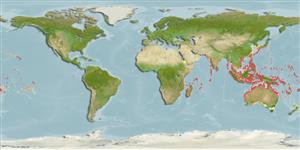Common names from other countries
Environment: milieu / climate zone / depth range / distribution range
Ecologia
; intervalo de profundidade 0 - 25 m (Ref. 349). Tropical; 36°N - 44°S, 32°E - 138°W
Indo-Pacific.
Length at first maturity / Tamanho / Peso / Idade
Maturity: Lm ? range ? - ? cm Max length : 32.0 cm SHL macho/indeterminado; (Ref. 101509); common length : 17.0 cm SHL macho/indeterminado; (Ref. 101509)
Shell length varies between 8.5 cm and 32 cm (Ref. 101509). Found in coarse sand with coral rubble and algae. Littoral to sublittoral, in tide pools and low tide level (Ref. 349). Inhabits seagrass beds (Ref. 98586).
Life cycle and mating behavior
Maturidade | Reprodução | Desova | Ovos | Fecundidade | Larvas
Members of the order Neotaenioglossa are mostly gonochoric and broadcast spawners. Life cycle: Embryos develop into planktonic trocophore larvae and later into juvenile veligers before becoming fully grown adults.
Smith, B.D. 2003. (Ref. 3116)
Categoria na Lista Vermelha da IUCN (Ref. 130435)
Categoria CITES (Ref. 108899)
Not Evaluated
Not Evaluated
Ameaça para o homem
Harmless
Utilização humana
Pescarias: espécies comerciais
| FishSource | Sea Around Us
Ferramentas
Mais informação
Idade/TamanhoCrescimentoComprimento-pesoComprimento-comprimentoMorfologiaLarvasAbundância
Fontes da internet
Estimates based on models
Preferred temperature
(Ref.
115969): 23.3 - 29.3, mean 28.3 (based on 3868 cells).
